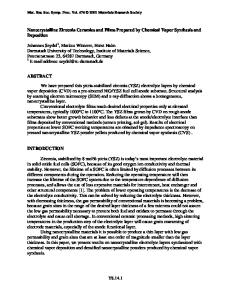Solvothermal synthesis of zirconia and yttria-stabilized zirconia nanocrystalline particles
- PDF / 385,874 Bytes
- 10 Pages / 612 x 792 pts (letter) Page_size
- 101 Downloads / 430 Views
A solvothermal method was used to prepare zirconia and yttria-stabilized zirconia (YSZ) particles using zirconium hydroxide and yttrium hydroxide particles as precursors and ethanol or isopropanol as reaction media. The particle properties were characterized with x-ray diffractometry, scanning electron microscopy, transmission electron microscopy, thermal analysis, laser particle-size analysis, nitrogen adsorption (Brunauer–Emmett–Teller method) and Zeta potential analysis. Cubic/tetragonal ZrO2 and YSZ nanocrystals with crystallite size around 5 nm were obtained. The effect of different hydroxide precursors, attrition milling of hydroxide precursors, solvothermal processing conditions, and mineralizer was investigated and discussed by referring to the crystallization process of zirconium hydroxides.
I. INTRODUCTION
Zirconia-based ceramics are widely used in a broad range of applications due to their specific properties in mechanical, thermal, electrical, ionic conducting, optical, and catalytic applications and have attracted the interests of both academia and industry for a long time.1–3 To further improve the performance of zirconia-based ceramics, it was suggested that achieving “nanostructured” materials that consist of uniform nano-sized grains may be an effective approach. It is expected that compared with conventional zirconia-based ceramics made up of microsized grains, nanostructured materials will not only possess better or some novel properties but also require lower sintering temperature as a result of the higher sinteractivity of nano-sized powder precursors.2,4–6 However, a prerequisite to nanostructured ceramics is to control the processing parameters to obtain nanosized powder precursors that are as less agglomerated as possible.1,7 In the past decade, many attempts have been made on the preparation of high-quality nanopowders. Till now, a variety of wet chemical processes, such as homogeneous precipitation, spray pyrolysis, sol-gel and nonhydrolytic sol-gel, and hydrothermal synthesis have been developed for the preparation of nano-sized zirconia-based ceramics powders.8–13 Among these methods, hydrothermal and solvothermal synthesis can produce uniform and crystalline nanocrystallites at low temperature without the need for post-synthesis heat treatment.8,10,11,13 a)
Address all correspondence to this author. e-mail: [email protected] DOI: 10.1557/JMR.2007.0012 46
http://journals.cambridge.org
J. Mater. Res., Vol. 22, No. 1, Jan 2007 Downloaded: 05 Apr 2015
Recently, using ethanol, isopropanol, or their mixtures as reaction media, our group reported the solvothermal synthesis of yttria-stabilized zirconia (YSZ) nanocrystals (about 3.5 nm) in the form of soft agglomerates by a simple one-step processing.14 It was suggested that the alcohols will suppress the crystal growth and agglomeration of nanoparticles, and as a result highly dispersed zirconia and YSZ nanoparticles with ultrafine crystallite size (3–4 nm) were obtained. The synthesized YSZ nanocrystals have agglomerate sizes (
Data Loading...











